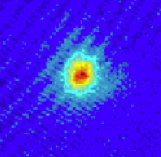Steps toward a new quantum fluid
Physicists regularly trap and cool atoms with lasers to form quantum fluids such as the Bose-Einstein condensate, but some researchers have recently shifted their attention from atoms to molecules, whose internal complexity could give rise to new phenomena.
One way to do this is to cool pre-existing molecules, and so far, it has been possible to cool a diverse set of molecules, though not yet to both high densities and ultracold temperatures. An alternative method is to first cool overlapping clouds of individual atoms and only then coax them into forming molecules. Using this technique, researchers have created ultracold molecules from weakly bound pairs of different alkali metals, notably potassium and rubidium. But such molecules always contain an even number of spins, so that electrons with opposite spins tend to pair up. Hideaki Hara of Kyoto University and colleagues are instead working to make molecules that combine atoms from different columns of the periodic table, which will contain unpaired spins and should reveal new types of behavior.
As a step towards that goal, the researchers report in Physical Review Letters simultaneously trapping lithium and ytterbium. By weakening the trap to let the most energetic ytterbium atoms evaporate, they cooled the remaining ones to below a microkelvin. Collisions cooled the lithium-6 to the same low temperature, which was one tenth of its Fermi temperature. This degenerate state coexisted, in separate experiments, with either fermionic ytterbium- or bosonic ytterbium- , each of which was also in the quantum regime. – Don Monroe





